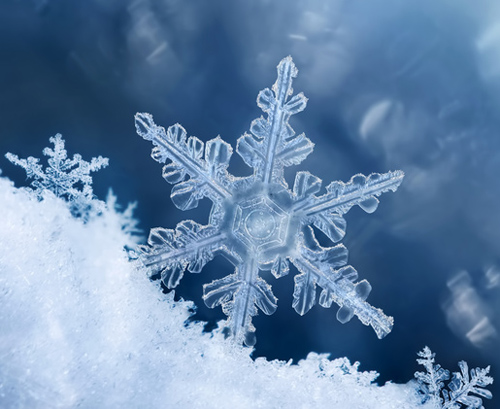The Mineral ice

Although many people do not think about Ice as a mineral, it is a mineral just as much as Quartz is. Ice is a naturally occurring compound with a defined chemical formula and crystal structure, thus making it a legitimate mineral. Its only limitation, in comparison to all other minerals, is that it is not stable at room temperature.
Ice is colorless, unless impure. Flaws and cracks cause it to have a white color. Snow is colorless, but the reflections of its crystal sides cause it to appear white. Snow has a most interesting crystal habit. Each crystal flake of snow forms a unique hexagonal pattern, with intriguing and interesting shapes that are all very different. Snow crystals cling together to form snowflakes.
Hailstones are formed in thunderclouds, where small water particles are tossed about from the wind, accumulating layers of Ice. When the Hailstones get heavy and can no longer remain suspended in a cloud, they fall to the earth. Hailstones up to 5 inches (13 cm) in diameter have fallen in certain regions.
Glaciers are formed when snow fails to melt and accumulates, and eventually starts "flowing" downhill like a river. When a moving glacier reaches a body of water, it forms Icebergs, or floating "mountains" of compressed snow.
Color
Colorless, white, gray, brown. The actual color of pure Ice is colorless with a slight blue tinge. Ice in glaciers have a darker blue to bluish-green color.
Properties
Streak
White |
Hardness
1.5 |
Transparency
Transparent to translucent |
Specific Gravity
0.9 |
Luster
Vitreous |
Cleavage
None |
Fracture
Conchoidal to uneven |
Tenacity
Brittle |
Other ID Marks
1) Melts at 32º F (0º C), transforming into water.
2) Has a lower specific gravity than water, causing it to float in water.
|
Additional Information
Composition
Hydrogen oxide. May be impure. |
In Group
Oxides; Hydroxides |
Striking Features
Floats in water and melts at 32º F (0º C) |
Varieties
-
Spongy mass of Ice formed in flowing streams.
-
Dew that freezes and forms crystals of Ice.
-
Moving mass of compressed snow and Ice that flows down a mountain.
-
Coating of Ice over other material. Glaze is formed during freezing rain storms, when the ice forms a sparkling layer over trees, telephone wires, etc.
-
Rounded pellet of Ice containing alternating layers of snow and solid ice.
-
Mountain of solid Ice that breaks away from a landmass and floats in the ocean. Iceberg masses are 9/10ths below the water.
-
Form of Ice that accumulates as non-liquid precipitation.
-
Individual snow crystal. Forms as in small,
perfect, hexagonal crystals.
Distingushing Similar Minerals
There are no minerals similar to Ice.